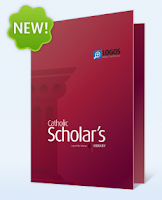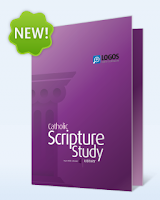If you use a computer to study Scripture, you’ve probably come across Logos. The impressive Bible software is extremely popular among pastors, scholars, theologians, and serious students of Scripture, helping thousands to approach the Bible more deeply.
At it’s core, the program operates kind of like a library. The base Logos software is free to download, running brilliantly on either a PC or a Mac, and is scalable based on how many resources you want to purchase. Like a library you buy more books as you go and add integrate them into your digital collection.
Right out of the box though you get a number of Bibles, books, and resources for free. But the catalog features more than 17,000 other resources including complex theological tomes, Scripture commentaries, lives of the saints, and maps, photos, and primary texts from every century in Church history.
In the past, the software has been mainly geared toward Protestants, which meant that Catholic users had to wade through a number of anti-Catholic material. But Logos has recently decided to expand their offerings to the Catholic world which is exciting news.
Two new Catholic software packages are now available, thanks in part to Logos Catholic product manager Andrew Jones, and after having the chance to test-drive them I have to say that I’m completely blown away.
The Catholic edition is simply mind-boggling. It includes a number of Catholic-translation Bibles like the NAB and RSV, but it surrounds the Scripture with commentaries, devotional works, sermon collections, Church documents, popular books, and more.
While exploring the program I kept wondering, “what would St. Thomas or St. Augustine give to have access to this software?” Logos provides any modern, computer-toting Christian with more resources then any Church doctor ever had.
Here’s Andrew with a general overview of the Logos Catholic edition:
Here are seven ways that the Logos Catholic software will revolutionize your faith:
1. The software wraps the Bible in Tradition.
Pope Benedict XVI’s recent exhortation Verbum Domini (The Word of the Lord) explained how Catholics should never separate the Bible from the Church’s Tradition. The two go hand-in-hand and in fact flow from the same stream.
The Catholic package from Logos is one of the best ways to study the Bible in just this way. Andrew explains how that happens:
“Logos is not just a “reader” for texts. Rather, the texts become integrated into a system that links them all together at the level of the lemma, the roots of the individual words, and keys the whole library to the Scripture. The Scripture is a hub around which the vast library revolves– the Bible is literally surrounded by the Tradition.
One can start with Scripture and work his way through the Tradition, always focused on the reading, or one can start with a dogma or doctrine and work his way into the Scripture. And throughout it all, there are dictionaries, lexicons, and encyclopedias.”
What does St. Augustine say about the opening chapters of Genesis? Where has the Church seen the Eucharist in the Bible down through the centuries? What do different saints have to say about each of Jesus’ parables? The Logos Catholic software brings all of those answers right to your fingertips.
2. You can go deeper into every aspect of Catholicism.
According to their website, Logos “allows you to approach the doctrines of the Faith from every angle–the Scriptural, liturgical, theological, mystical, or magisterial. Never before has studying the Faith been so rewarding or so easy.”
One thing that makes it so easy is that you can explore thousands of resources by topic. So if you want to learn more about Confession or the Immaculate Conception, for example, you just enter the phrase and Logos will provide a well-organized package of information.
What’s even greater is that the software is “smart” in the sense that if you search for the word “communion”, you’ll get results not just for that word but also for “Eucharist”, “the Lord’s Supper”, or for any mention of the Greek or Hebrew equivalents.
3. The Church fathers provide you daily commentary.
At breakfast each day, I flip open my Magnificat and read through the daily lectionary readings before Mass. This helps a lot as I’m familiar with the readings before I hear them proclaimed during Mass. But imagine if instead of just reading the passages yourself, the greatest Church fathers, doctors, saints, and theologians gave you personal commentary on each of the daily readings, every single day.
What did St. John Chrysostom have to say about this parable in Matthew? How did Origen read that verse? How did Cardinal Newman, John Paul II, or St. Therese of Lisieux understand that passage?
Logos provides those answers. When you fire up the software each day, the Home Page features the daily readings along with a wealth of commentary for each passage.
4. Fit 2,000 years of Catholic tradition into your pocket.
I just got an iPhone a week ago and one of the first things I did was download the free Logos iPhone app. Once I gained access to the Catholic software library I instantly had the full Summa Theologica, dozens of commentaries, and hundreds of books and articles all on my cell phone. The iPhone and Android apps allow you to carry Scripture and centuries of Tradition wherever you go and, of course, it’s all searchable on the spot.
5. You can dig into the original Biblical languages without knowing Greek or Hebrew.
When you read the Bible and discover an intriguing word, its often interesting to see where that word shows up elsewhere in Scripture. It’s also fascinating to learn how the same Greek and Hebrew words can be translated differently in varied passages. But even if you’re like me and don’t know a lick of Greek or Hebrew, Logos has hundreds of language tools and that allow you to analyze Scripture in its original languages.
6. It’s the best Catholic Bible software available.
When it comes to other Bible-study software packages, Faith Database ($40), Biblia Cerus (free), and E-Sword (free) are certainly cheaper solutions. But I’ve tried each of those programs and found them extremely clunky. They do share some of the same features as Logos, but the Logos Catholic software really blows them out of the water.
And it’s not even close. Logos is larger—over 17,000 books and resources—cleaner, simpler, and the back-end coding makes research and study much smoother. It also includes many modern books and resources from writers like Dr. Scott Hahn and Dr. Peter Kreeft.
What really sets it apart, though, is that when you use the program you feel like you’re working with a librarian rather than a lifeless computer program. It acquires, catalogs, and organizes your resources, and helps you, the digital patron, find the information you’re looking for, quickly and easily.
7. Top scholars and apologists use Logos.
If all of that isn’t enough, consider the people that are using the Logos Catholic software. Apologist Patrick Madrid says, “I’ve been a happy and satisfied Logos customer and cheerleader for over 15 years and have recommended the software countless times to folks on my weekly radio show, at my parish seminars, and at my talks. I’m very excited about the Catholic base packages and whole-heartedly recommend them.”
Other well-known Catholic academics like Mike Aquilina, Taylor Marshall, and Steve Ray have similarly praised the software.
After sharing all the great reasons why you should buy the Logos software, here’s the sobering caveat: it’s pretty expensive.
The Catholic Scripture Study Library package costs $490 and the premier Catholic Scholar’s Library package will set you back $790.
But after the initial sticker-shock wears off, consider this. If you’re pursuing a graduate degree in theology, philosophy, or ministry, the price is comparable to one typical college course or a few textbooks. Yet it’s way more powerful than either of those things. Also, according to Logos, if you bought the print copy of each book included in the Catholic library you’d spend more than $7,000. So if you consider the digital collection in that way it’s a huge bargain.
You might also think of some creative ways to afford the program. If you give talks or do freelance writing, perhaps use your stipends or writing payments to cover the cost. In fact harnessing this software might lead to even more speaking and writing opportunities making this a great investment.
However if you’re like me, someone without an academic background who is simply interested in deeper Bible-study, consider setting aside $10 a week. After a year you’ll have enough to purchase one of the Logos Catholic Scripture Study packages.
Despite its high price, the Logos Catholic software is the most powerful Scriptural tool in the history of Christianity. If you can find some way to afford it I can’t recommend it enough.
Other Reviews
– First Things (Dr. Steve Smith)
– Jeff Miller (at The Curt Jester blog)
– Michael Barber (Sacred Page podcast with Andrew Jones)
– Taylor Marshall (text interview with Andrew Jones)
– Thomas McDonald (at National Catholic Register)



